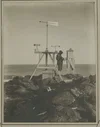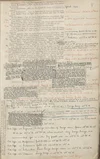Learn the science behind the weather with the Met Office

Every single day, millions of people tune in to the weather forecast. Whether dreaming of a white Christmas, planning an activity, or just wanting to know what to wear tomorrow, we all rely on the weather and the science of meteorology to predict and plan for our future. But, how much do you really know about it?
From preparing people for how the weather and climate change may affect them personally to supporting policymakers, international aid workers and industries in their operational decisions, national meteorological services around the world have a key role to play. In the UK, this is the Met Office, which has been instrumental in the development of weather and climate science since its inception in 1854. Its core mission is as true today as it was then - helping people make better decisions to stay safe and thrive.
Photograph of Met Office Presenter Clare Nasir in the weather studio, Met Office National Meteorological Library and Archive

Today, on National STEM Day, we are pleased to announce our collaboration with Google Arts & Culture on the launch of What’s the Weather? a new online hub showcasing the history and role of meteorology and the Met Office. The hub is a collection of highlights from the Met Office and the National Meteorological Library and Archive, brought to life through digital stories inviting audiences to learn about the science, history and impact of meteorology.
To help demystify the weather for all, these resources can be explored through three questions.
What is Meteorology?
Discover the world of meteorology and how integral it is to our daily lives: whether it’s learning about clouds, key meteorological terms like air masses or how storms are recorded over land and sea. Travel to the ends of the earth and experience extreme weather at Britain’s highest point and even space, or explore key moments in history from the Terra Nova Expedition to Antarctica through to the weather during the Derby Day Thunderstorm.
George Clark Simpson at Terra Nova base, Met Office National Meteorological Library and Archive

How do forecasts work?
Explore how a global network of scientists monitor the weather, from the factors to consider to the variety of instruments that are used. Learn about the history of the first ever weather radio forecast or find out about the Shipping Forecast. There are even unique records from the archive such as a report showing that the Titanic collided with an iceberg in 1912, and arguably the most significant forecast in the world; D-Day.
We see weather forecasters across our televisions, social media and apps, but do you know how we bring the weather to everyone?
Cutting from newspaper noting that the British Steamer Titanic collided with an iceberg, Met Office National Meteorological Library and Archive

Why does it matter?
The final section showcases the importance of weather – from understanding our changing climate, to being a source of scientific innovation and inspiration over centuries. Around the globe we are already seeing changes to weather patterns and average temperatures as a result of human-induced climate change. By making changes in our lives to #GetClimateReady, discover how we can all play a part in protecting our planet.
Cumulonimbus, Met Office National Meteorological Library and Archive

It is clear that meteorology is essential to understanding the world that we live in. Thanks to this partnership, we are delighted to be celebrating the centuries of data held by the Met Office and the National Meteorological Library and Archive to paint a rich picture of our weather past, and in turn our weather futures for everyone to understand.
Discover more about the science behind the weather at: goo.gle/metoffice






